Where there’s traffic there’s hope. Every visitor is a potential conversion, as in a lead, a customer or a subscriber. But no traffic means no conversions.
This is why content marketers work so hard at content promotion. They understand one of the first rules of content marketing:
The best content doesn’t win.
The best promoted content wins.
This is a guide for content promotion, complete with 76 specific content promotion activities. Together, they are a checklist for driving traffic to blog articles.
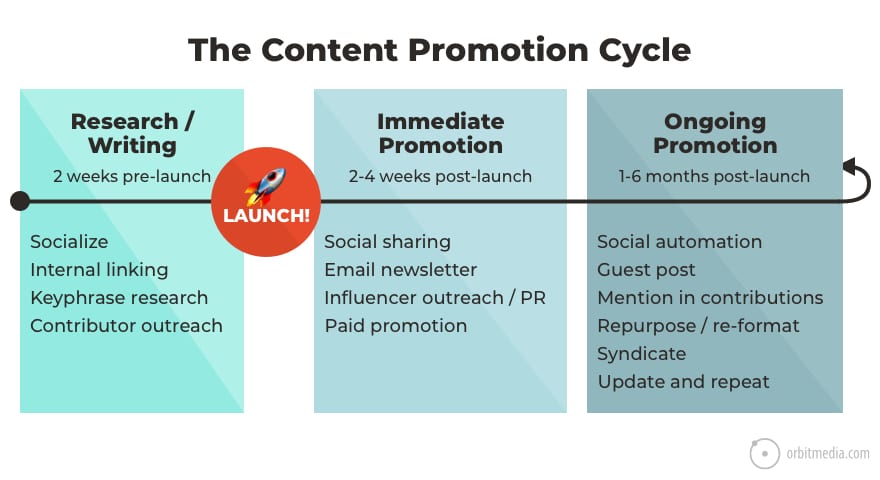
We’ve broken down the tactics into three sections.
We’re showing how to promote the article before, during and after the go-live date.
Section one (1-8): Promotion prep work (pre-publishing)
These actions are taken during the content creation process. Each increases the potential reach of the article.
Section two (9-57): Launch day promotion
These actions are taken on the day or two around the go-live date. They include social media and email marketing.
Section three (58-76): Post-launch promotion
These are done in the days and weeks after an article is published. Because the job is never done. It just begins again.
We’ve prioritized the tactics within each section.
This is based on our experience of the effectiveness of each tactic. As usual, prioritization is the key to success.
How has this article already attracted 26,000+ visitors? This is revealed in the final tip at the end.
Section one: Pre-publish promotion
Although these tactics may seem like aspects of content creation, they are really all about content promotion. You are engineering the article to get traction.
1. Ask a related question on social media
Step one is to socialize the topic. Go to social media and post a related question. Did people engage with your post? Did it trigger conversation? Who engaged with you? Did their input deepen your understanding the topic?
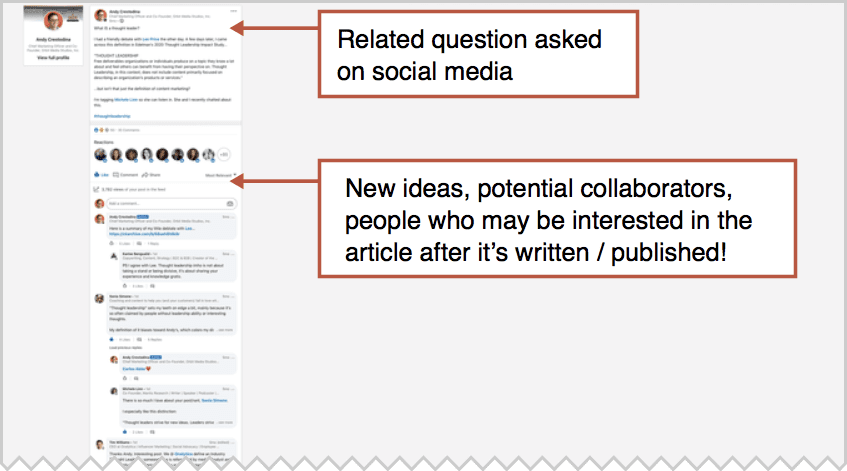
Make a list of these people or save the link to the social post so you can go back and see who is interested in your topic. You’re going to connect, collaborate and co-promote later.
2. Align the post with a keyphrase
Search is one of the most durable ways to drive traffic over time. Align your content with a keyphrase so Google can help people find you. Do a bit of keyword research and pick a phrase that meets two criteria:
- People are searching for it (good search volume)
- You have a chance of ranking for it (not too competitive, based on your website’s Domain Authority)
Use the phrase at the beginning of the title, in the header and several times in the body text.
3. Work on the semantically-related phrases
Find the phrases that are semantically related to your article, then as you write your article, incorporate these into the piece.
- Answer the related questions (they’re in the “People also ask” box)
- Touch on the related topics (they’re suggested by Google as you type a query)
- Go deeper than the articles you’re competing with (the other pages that rank for your target phrase)
Now you’re targeting the topic, not just the keyphrase, which is the key to search and Semantic SEO. Here are the step-by-step instructions for finding the phrases most closely related to your topic.
4. Include contributor quotes from experts and influencers
Content created together with other people is much easier to promote. This is one of the reasons that contributor quotes, roundups and interviews are so popular. They include “ego bait” which drives social engagement.
An ally in creation is an ally in promotion.
Include others in your article so you’ll have opportunities to mention them in later social posts. Unless the article is filled with people, it isn’t optimized for social media.
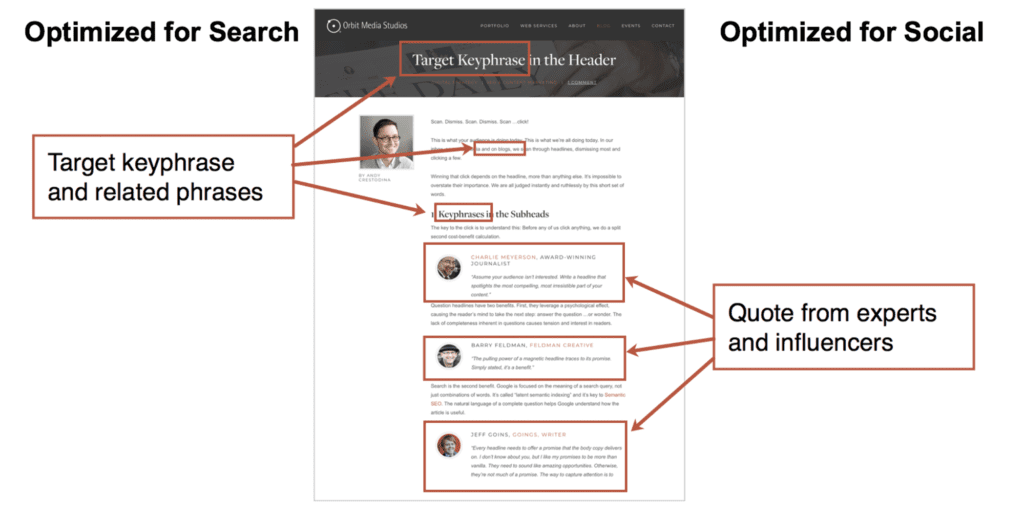
 |
erin hueffner, ZEN DESK“Think like a journalist: if you were writing a news story, where would you go for an expert source? Professors love to talk about their subject areas – search a university’s website for contact information. You can also look for authors on your topic (do a quick search on Amazon) then reach out. If you reach out and they don’t seem like a fit, ask if they know anyone who is right for the subject.” |
5. Add diagrams and original graphics
Original graphics will make the content much easier to promote later, in social media and in PR. They also make the content much more engaging. Don’t just add an image. Add an image at every scroll depth.
6. Link to the new post from older posts
You’re not done publishing a new article until you’ve linked to it from an old article. This kind of internal linking is good for readers and it’s good for SEO.
Add a few links on past posts as “related links” at the bottom or links within the body text. Either way, try to use the target keyphrase of the new as the text within the link on the old article. That little link can help Google understand what your new article is all about.
The ideal internal links are on your highest-traffic articles. These are the most likely to send visitors toward your new piece.
7. Add Click to Tweet buttons
Make the juiciest quotes easy to share. Set up a little button that lets readers share on Twitter with a simple click. You can do this manually using Click To Tweet or find a plug-in for your CMS that does it for you.
8. Add anchor links to subsections if the article is long
If it’s a really big piece, adding a mini table of contents at the top with anchor links lets visitors jump down deeper into the article. This post does this.
And those anchor points will also help you keep it alive in social media later. More on that next.
Section two: Launch day promotion
Most content marketers focus efforts here, with email marketing and social media promotion. This checklist covers also uncludes a lot of less common tactics. Everything here will be more effective if you nailed those pre-publish items above.
Social promotion:
9. Tweet it
Social media is more than a dumping ground for links. It’s for conversation, research and networking. But of course, promote your content here.
When you tweet your new article, include these items from our social post checklist to increase engagement and the click through rate to your content:
- A number
- A specific benefit
- A question
- A special character
- A quote
- A hashtag
- Mention contributors, commenters and those who shared
We’ll talk more about mentions in a bit.
10. Post on LinkedIn
Same as Twitter, pull out all the stops. Here’s what a hard working LinkedIn post looks like:
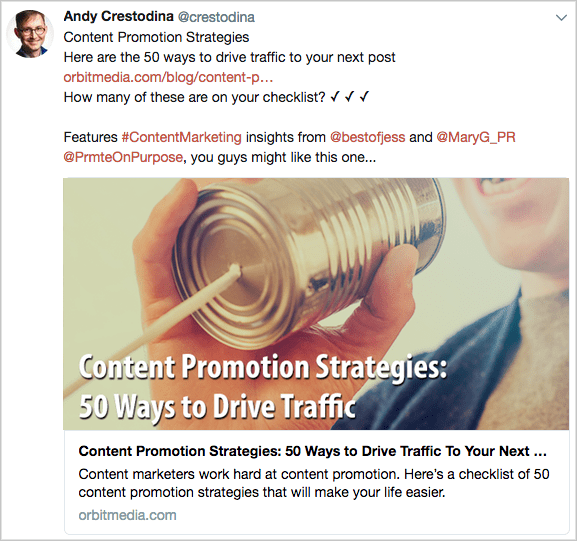
If you have a business page and a personal page, share from both. Or post it to the business page first, then share that post from your personal page. This gives visibility to both.
11. Post on Facebook
Make sure there’s an image and that the headline looks good. Mention anyone you included in the article.
12. Social media video: the one-minute commercial for your content
By far the most effective way to promote content in social media is with video. As with many things in content marketing, it takes 10x the effort, but drives 100x the results.
Use everything in the checklist above, plus the following:
- Add captions
- Add campaign tracking code on the link
If you track it properly, you’ll get accurate attribution for your efforts. The following is typical for our social videos. It is literally 100x the results of a typical social post. Not bad, right?
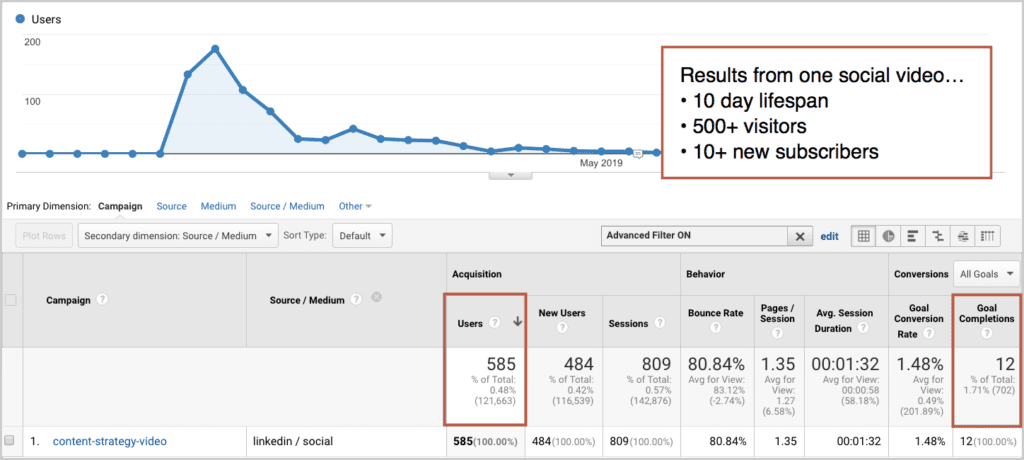
Here is our second-by-second breakdown of one-minute social videos. Just follow those steps!
13. Ask for quick engagement on these social posts
When a post on Facebook or LinkedIn gets early engagement (likes, comments and shares) then that social algorithm is more likely to show to more people.
The goal is to trigger the algorithm and therefore dramatically increase reach.
Yes, this means promoting the post that promotes the article that promotes the business. It sounds weird and indirect, but that’s just how things work these days.
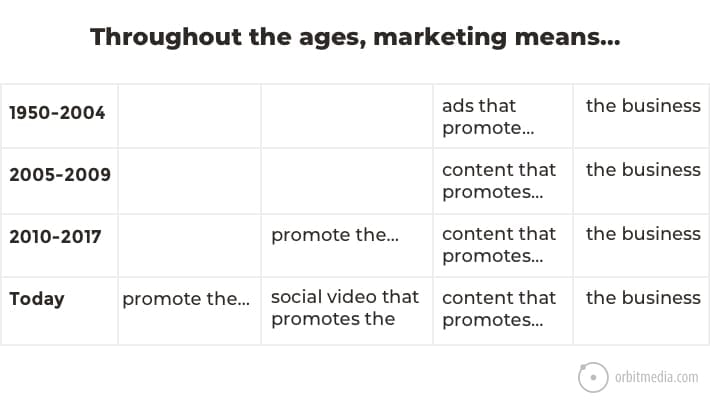
You’re looking for a quick boost from friends, family and partners. Reach out to them on Slack, Discord, Google Hangouts or wherever your allies meet.
But don’t send them a link to the article. Send them a link to the social post. Ask them to engage with that post, to like, comment and share.
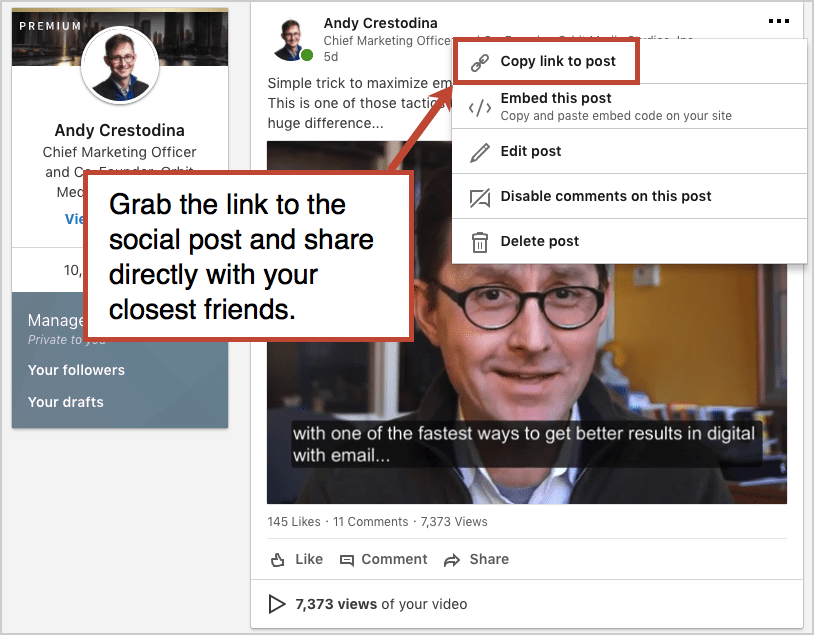
14. Leverage employee advocacy
Got a team? Any chance they’d like to chip in and help with marketing? This is a group that can drive quick wins for social engagement. Just drop a message like this into the company chat.
“Hey guys! We just published a great piece of content on [topic] and It’s time to promote it. This process is really important to our business and every little bit of engagement helps.
It’s totally painless. Just click on this link and give it a like and comment. Huge bonus points if you share it with your network. Thank you all! These little things make a big difference…”
Make it fun, but optional. Do not require (or expect) that your employees use their social streams to promote the business.
ProTip: Got a team member who is very active promoting the company content? Write them a LinkedIn recommendation. Now everyone sparkles a bit more.
15. Help the sales team share it with prospects
If the article answers questions that your prospects ask during the sales process (the best content does) then make sure that the sales team knows it exists and can easily pull it out in meetings.
Here are four ways to wrap it up in a bow for use in the sales process:
- Write sample email copy they can use to send it directly to prospects
- Make presentation slides out of the best tips, charts and quotes
- Polish it up into a nice PDF guide that they can email as a follow up to meetings
- Build up a repository of these articles, which lists common sales questions and links to articles that provide your best answers.
This all works best when the sales team is involved in the content creation process. The idea is to put your content in front of your most valuable audience: your potential buyers.
 |
Marcus sheridan, IMPACT“One would think that if a marketing department produces world-class sales enabling content then the sales team would naturally integrate it into their process. This, without question, is far from the truth. Here’s the reality: Unless you truly take the time to teach your sales team the WHAT, HOW, and WHY of integrating content into the entire sales process– they will struggle mightily. Remember– this isn’t something they’ve ever done before. They are used to relying on their own skills, communication, and words– not so much the company’s. But once they catch the vision, and combine their skills with the tools the organization has provided, their success rate explodes. Closing rates spike. Sales cycles plummet.” |
 |
ardath albee, MARKETING INTERACTIONS“Sales reps are always looking for relevant ways to engage their opportunity accounts. Give them a cheat sheet that summarizes premise, key takeaways and the question it answers for the persona. Help them use your content to start a conversation. The prospect may forward the email to their team or others on the buying committee. Extending reach with prospects helps your reps build pipeline momentum. It may also result in more blog subscriptions.” |
16. Share again, with mentions
The social mention is one of the best ways to make your content visible. When you tag someone in your social post (either with an @ mention or tagging an image) they will likely see the notification and tap to see the post.
If they are somehow connected to the content, they’re likely to share. Here’s where your pre-publish work becomes very useful. Mention all of these people:
- People who interacted with when you socialized the topic
- People who commented on the article
- People who contributed a quote to the article
- People who otherwise were included
- People who conducted research you mentioned in the article
- Brands that you used as examples
Each of these are opportunities to both enlist help in promoting the content and to grow your personal network.
 |
jessica best, BARKLEY“I love to share a nugget I learned from each article when I share it. Rather than just plop a link out there and rave about how good it is, I offer a proof point. Even if folks don’t click, hopefully they learned something. Think of how you’d talk about the article at a happy hour: “I read this great article on celebrity pet endorsements where I learned that Grumpy Cat only endorses five products…“ |
17. Cross the streams, showing gratitude across networks
This tactic triggers more engagement on more networks.
A few days after sharing it on Twitter, check BuzzSumo to see who shared and commented. Pick out any familiar faces and now share the article again on LinkedIn (or any other network). As you do, thank (and tag) these people for their earlier shares and comments.
Since they’ve already seen and liked the article in Network A, they’re very likely to share, like and comment again in Network B.
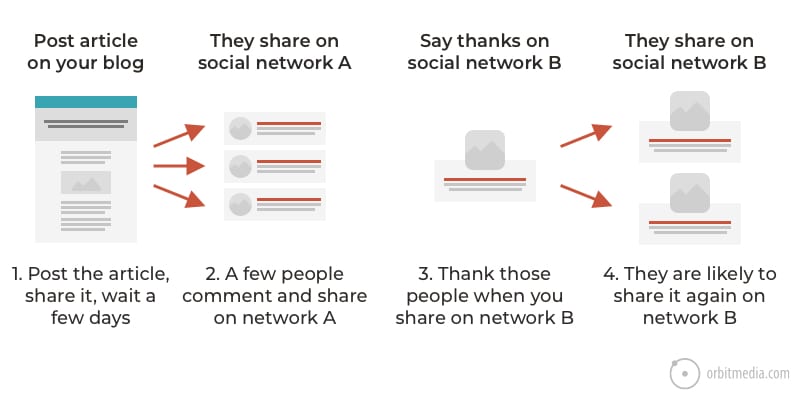
18. Targeted sharing: mention people who will love the article
Use a Twitter search tool to find relevant people with large followings who would be interested and likely to share. Mention one or two of them at the end of another tweet.
19. Schedule near future tweets at high traffic times
Schedule at least four tweets for the future. Time them to the highest traffic times for your audience (according to FollowerWonk). Schedule a few for day two, a few more in a few days, and a few more next week.
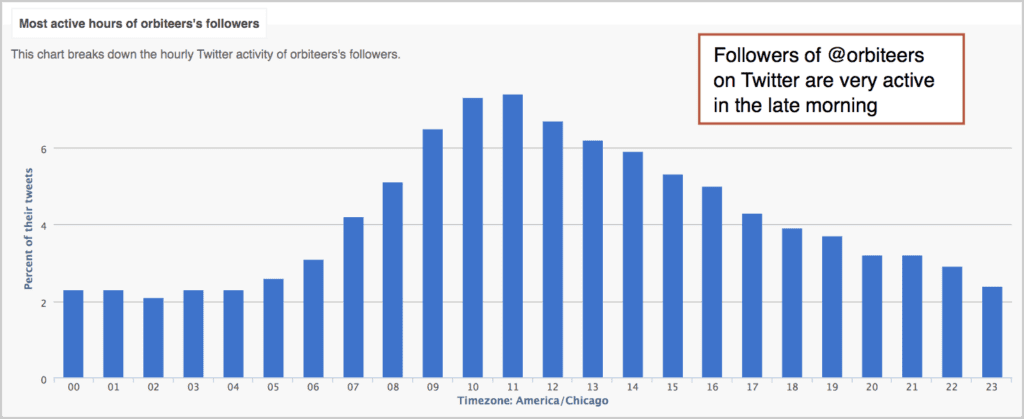
To keep the posts from looking repetitive in your streams, vary the posts so they are all unique and stand on their own.
- Link to deeper interior sections of the article (this is why you added those anchor links earlier)
- Use different quotes from the article
- Share statistics and data from the article
- Use different visuals from the content in the social posts
20. Post it again at low traffic times
The “best” time to share is also the noisiest. Try sharing when social streams are quiet, such as the middle of the night. Counter-competitive timing can make you more visible. It can also attract an international audience.
 |
sean work, JUDICIOUS“Put out a bangin’ article and find a great image to go along with it. Then post it to our Facebook account in the wee hours of the night. That kind of counter-competitive timing often works really well.“ |
21. Share at 9:57 or 10:03, just before or just after the hour
A lot of people use social scheduling tools. Many of those scheduled shares to go out at the hour or half hour. To avoid getting buried in this mix, schedule your Tweets to go out just before or just after the hour. Jay Baer calls these “micro-opportunity windows.”
 |
jay baer, CONVINCE & CONVERT“Many businesspeople are checking their social media accounts just before and after the top of the hour or the bottom of the hour. It works like this: Meeting is scheduled from 1-2 pm. Meeting lets out slightly early at 1:57 pm, and attendees check Twitter on the way back to their desk. Meeting goes a little long, and that dip into social media occurs at 2:03 pm. You get the idea.“ |
22. Social media automation
Rather than manually creating each and every tweet and LinkedIn post, promote your content using an automated tool. We use CoSchedule.
CoSchedule lets you write the post once, but with variants. It will then post to social networks in an ongoing rotation. Before judging this tactic (and for tips on doing it right) check out these instructions for social media automation.
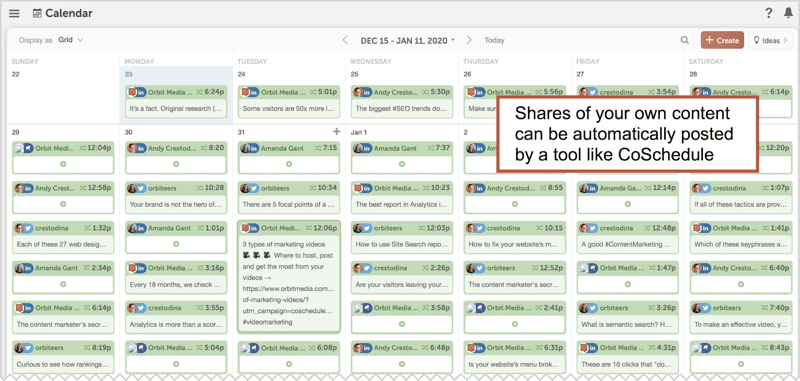
23. More social media automation
CoSchedule automates sharing of your content from your social accounts. Here’s a way to automate the sharing of your content from other people’s accounts: Quuu.
Post your article to Quuu and once approved by their team, it will automatically be shared from the accounts of other people who use Quuu. Two caveats: you may have to lend your accounts to other Quuu users, and you may have to pay for the service. If it works, you may drive tons of traffic without a ton of effort.
24. Mention it on a Twitter Chat
If you can get to know the organizers of one of these chats, you may be able to pitch the topic as an idea. They may invite you to be a featured guest. It could be a lively conversation where everyone learns.
Either as a guest or just a participant, you can drop the link to your article anytime during the chat. Aftwards, you can also send direct messages to people who connected with you during the conversation.
25. Pin it to the top of your Twitter feed
Now that you’ve seen which tweets get the most traction, take the best one and pin it to the top of your Twitter feed.
26. Now follow a few people who are interested in the topic
Search twitter for people with bios that include words that are relevant to the topic of the post, then follow them. These people will see your recent tweet at the top of your stream. They’re more likely to follow you since the content is especially relevant to them at that moment.
27. Pin it on Pinterest
This works best if you have highly visual content (such as the diagrams we recommended above) or an article with a great picture. Pinterest is an underrated network and powerful source of traffic.
28. Feature it on your LinkedIn profile
The featured section is high near the top of your LinkedIn profile. And it has images, so content here is highly visible. And that’s durable visibility. No algorithm, no competition. Post your article here.
It’s an easy win.
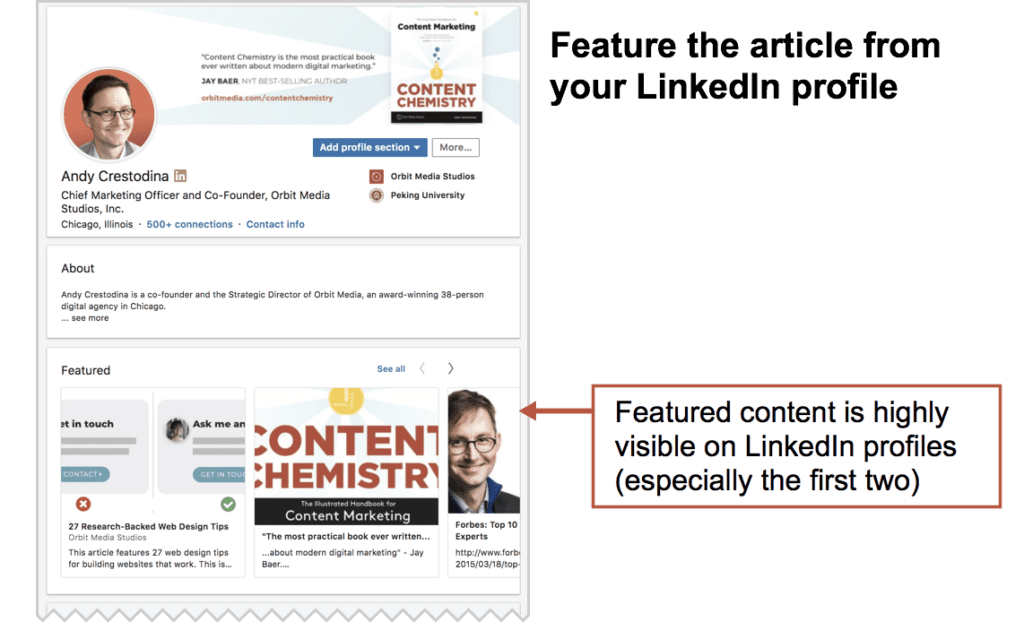
29. Share it in LinkedIn groups
LinkedIn Groups are making a comeback. Share the link with a group in which you are actually engaged (no drive bys please).
Plan ahead and start a relevant conversation with people from the group before you publish. This is an excellent place for the first step in this process, socializing your topic.
30. Share it in Facebook Groups
As above.
31. Try older networks
A lot of the older platforms are still out there. If you had an account there once, it’s probably still active. Don’t expect much, but hey, it only takes a minute to log in and share!
- Digg
- Alltop
- Popurls
- Ezine Articles
RIP: StumbleUpon, Delicious, G+
32. Submit your content to news aggregators
If your content is newsworthy, consider submitting your site to news aggregators, including:
33. Post a summary on niche social sites
If you have accounts on any smaller membership sites, forums, association sites, networking groups, and anywhere else you can post content, post a short summary and a link to the article. Include an image whenever possible.
If it’s a marketing article, here are some niche communities where you can promote, share and engage.
- GrowthHub (formerly Inbound)
- Growth Hackers
- Product Hunt
For best results, engage in these communities first. Make an investment before attempting to make a withdrawl.
34. Answer a related question on Quora
Someone is talking about your topic on Quora. Find the related questions and jump in with a thoughtful, detailed answer. Don’t just repost your article. Write something sincere and original, then mention and link to your article.
The ideal answer is on a question that’s getting a lot of traffic. Which Quora questions are getting traffic? The ones that rank. How can you find which questions on Quora rank? Use SEMrush.
35. Post on Reddit
Spend some time picking out the right subreddit and getting to know it’s redditors. Share your post and start a conversation.
 |
mary Garrick, UPWARD“I am a huge fan of Reddit. With its labyrinth of subtopics (subreddits), it offers marketers the ability to drill down to a specific audience (segmentation FTW!). I’ve seen content take off in a viral way on Reddit–content that otherwise might never have reached that level of visibility written by lesser known but completely deserving authors.“ |
email marketing
36. Email Marketing: Use social media to find the best subject line
We finally get to email marketing.
This is generally the best channel for content promotion because it gives you direct access to your audience. There is no company (Facebook, Google, LinkedIn, Twitter) in between. But those platforms can indirectly help drive email marketing results.
- Social media is low stakes/high data.
- Email marketing is high stakes/low data.
- So use the former to guide the latter.
Look back at the feedback from all of that sharing you just did. Which posts got the most engagement? Check the likes, comments, shares and most importantly, click through rates.
Use the winning social post as your email subject line.
Just make sure the best part of the subject line doesn’t get truncated in the mobile inbox. You get fewer characters in mobile than social. Subject lines get truncated after 40-45 characters on mobile devices.
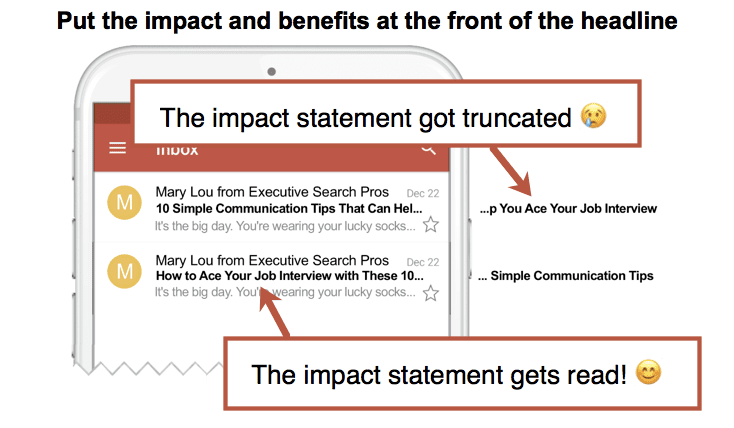
37. Email the article to your list
Time to send the article as a newsletter to your list. It should include the following:
- A sender name that’s a human, not a brand
- A compelling subject line, ideally vetted in social media
- Teaser text in the email that describes the main benefits in the content
- A compelling call to action. Add tracking code to the link.
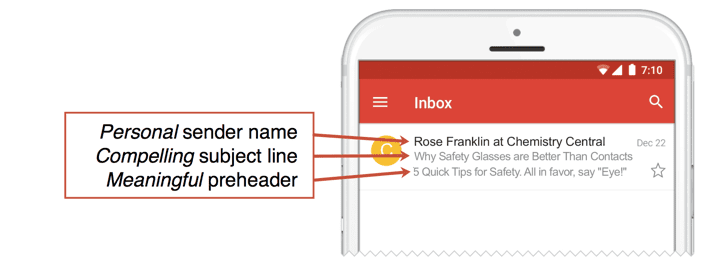
Send the email at a consistent time that works for your list. A lot of the research suggests early mornings and weekends, but test for yourself.
38. Send a second “In case you missed it” email
Three or four days after sending, run a report of the subscribers who didn’t open the first email. Send it again to this group in a follow up email with a different subject line.
The second email may add another 25% to the amount of traffic you got from the first email.
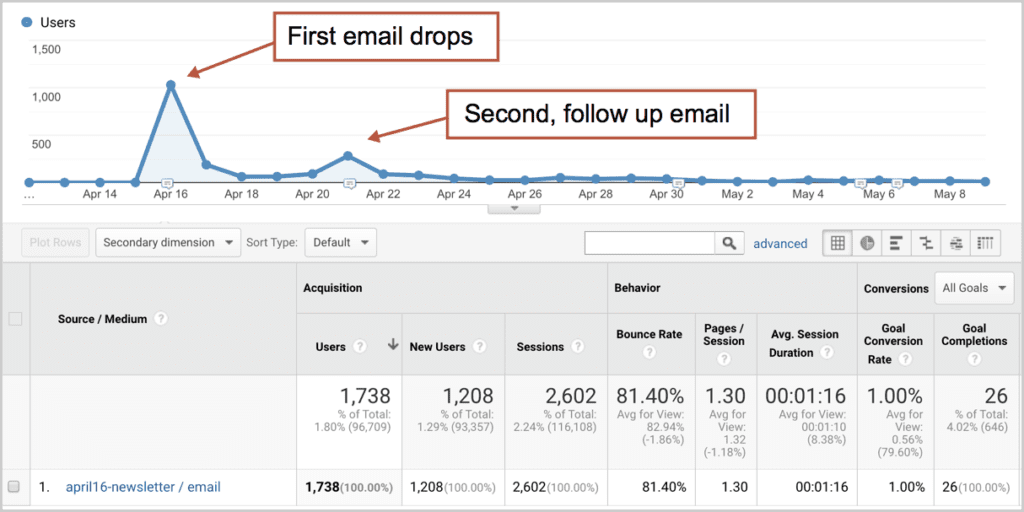
Think this is too much email? It’s not. Remember, these people subscribed to your list. They asked you to email them. If they’ve changed their mind, they can always unsubscribe.
pr and outreach
39. Email it directly to high-value contacts
Influencers in your industry, prospects in the pipeline, journalists and editors. One of these readers is worth a thousand strangers.
Put quality above quantity by taking a minute to send a warm, personal email, inviting that special someone to take a look and share their feedback.
Few people do this. Many people should.
 |
Lucy Literado, REPLY.IO“Content promotion is a tough job for every marketer out there mostly because great results require great effort. At Reply, we started using LinkedIn prospecting to enhance our promotion processes using our own email finding tool for the platform. However, we do personalize every single message and spend a lot of time on this kind of outreach to get the impact we want, but it’s totally worth it.“ |
40. Email your collaborators once it’s live
Even if you already mentioned them in social posts, send an email to everyone who contributed to the article. When they see the “You’ve been featured!” subject line, they’ll be happy they helped.
This email is a gentle nudge, asking them to help with promotion. Share a link to the latest social post or the article itself. Better yet, provide them with pre-written tweets or social-friendly images.
41. Send the embargo version to collaborators
If the article is a serious piece of research, give your collaborators time to plan their promotion before launch. Maybe they’ll want to write an article with their own insights on their site.
Prior to launch, email the article as an attachment and let them know the URL where the article will be published. Pull out some key points to show the highlights. The idea is to give them early exclusive access and to gently encourage them to write a related piece.
The team at Content Marketing Institute are the best at this. Here’s what they send:
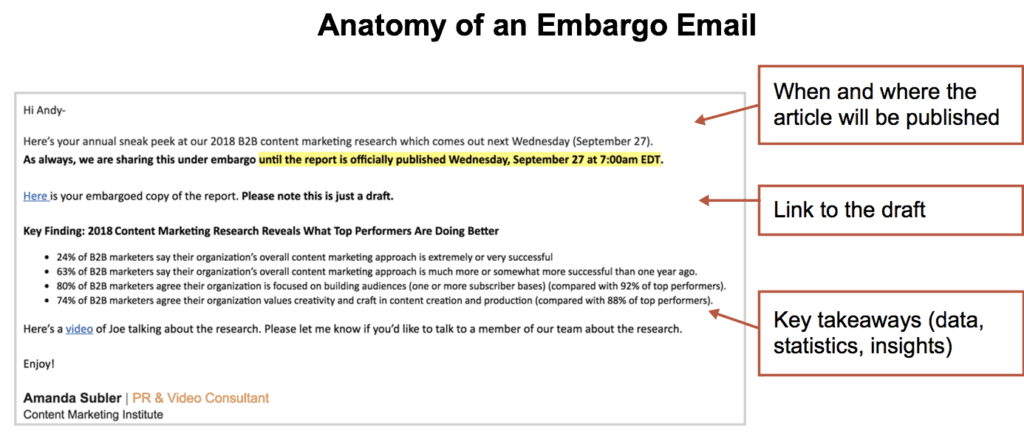
 |
amanda subler, CONTENT MARKETING INSTITUTE“When I came onboard at CMI we really had no coordinated publicity plan for our research. Once we instituted our outreach efforts, we significantly increased the awareness and coverage of our yearly research reports. Now our annual B2B Content Marketing research report is consistently cited throughout the year and is by far the number one driver of media mentions for CMI, as well as links back to our website and owned content.“ |
42. Email anyone the article links to
Did you cite anyone’s research? Mention anyone’s tools? Quote any authors?
Every link in your article is an opportunity to reach out, start a conversation and potentially enlist a new ally in content promotion. To them, you are a press hit. People love to share things that mention their work.
 |
stefan debois, SURVEY ANYPLACE“When you write an article, every outbound link is an opportunity to start a professional relationship with the author of the article you link to. Above everything, you should select outbound links that add value to your article and are meaningful to your audience. But even after applying these criteria, you often have the choice between different content resources from different authors to link to. Check these authors and go for the content from the author that is most likely to engage in a mutually beneficial relationship. And make sure to reach out to the authors before the article is published.“ |
Your blog is your greatest networking tool.
43. Try cold email outreach
We’re aren’t experts at this, but there are pros that get huge results by sending clever email copy to relevant people. Curious? What does a clever outreach email look like? Here are some cold email templates to get you started.
44. Put out a press release
Still a useful currency with journalists, the press release is an effective way to promote newsworthy content, especially if original research, strong opinion or a new angle on an old topic.
 |
Michelle Garrett, PR Consultant, Garrett Public Relations“When you write an article, every outbound link is an opportunity to start a professional relationship with the author of the article you link to. Above everything, you should select outbound links that add value to your article and are meaningful to your audience. But even after applying these criteria, you often have the choice between different content resources from different authors to link to. Check these authors and go for the content from the author that is most likely to engage in a mutually beneficial relationship. And make sure to reach out to the authors before the article is published.“ |
45. Answer related questions on HARO
“Help a Reporter Out” (also known as HARO) is a service that some journalists use to find sources. As a possible source, it’s a way to get coverage for your topic.
Register and watch for related questions. Don’t be discouraged of your pitches don’t get picked up. Even the pros are happy with a 1 in 4 hit rate.
What’s it like for the journalist your pitching to? Josh Steimle gave it a try and reported back on the chaos. See his tips for pitching at the end of that article.
ProTip: Save your HARO pitches in a doc so you can repurpose them as articles later.
46. Ask a friend to link to it
One of the quickest wins, but don’t overuse it. If the content is excellent and relevant to something your buddy made, they will likely be happy to help. That’s what friends do. Just send them a quick DM.
places to add links
47. Put it on your homepage
Does your latest article automatically get showcased on your homepage? If not, put it there manually. Your homepage is one of your most popular pages, right?
48. Add a link to it in your welcome series emails
When a visitor subscribes, they get a confirmation email, welcoming them to your list. Then they get a few more emails over the next few weeks, guiding them directly to your best content.
These are your welcome series emails.
They’re a powerful source of traffic. We use Active Campaign as our email service provider. In this report you can see how a one-time setup effort drives thousands of visits per year.
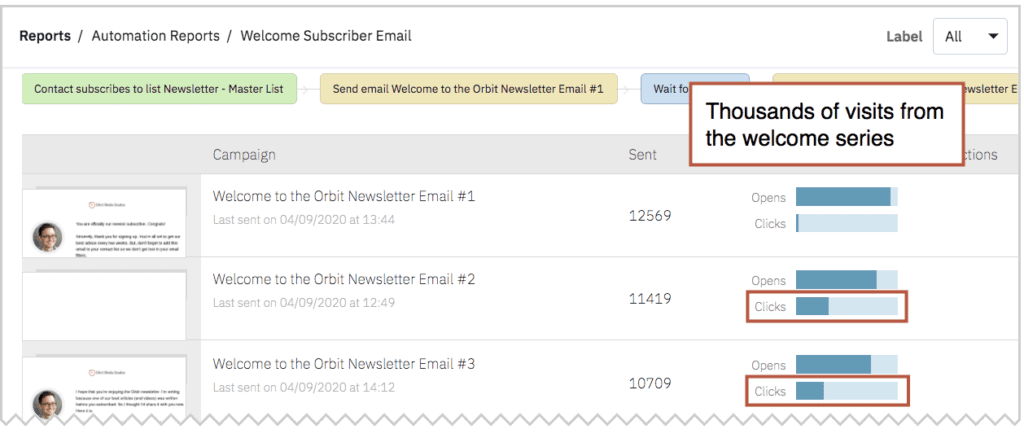
49. Add a link to your email signature
You send email every day. Every message is a chance to share your latest article. Updating your email signature takes less than a minute and can bring your latest piece to the attention of everyone you correspond with.
WiseStamp makes really nice email signatures like this one:
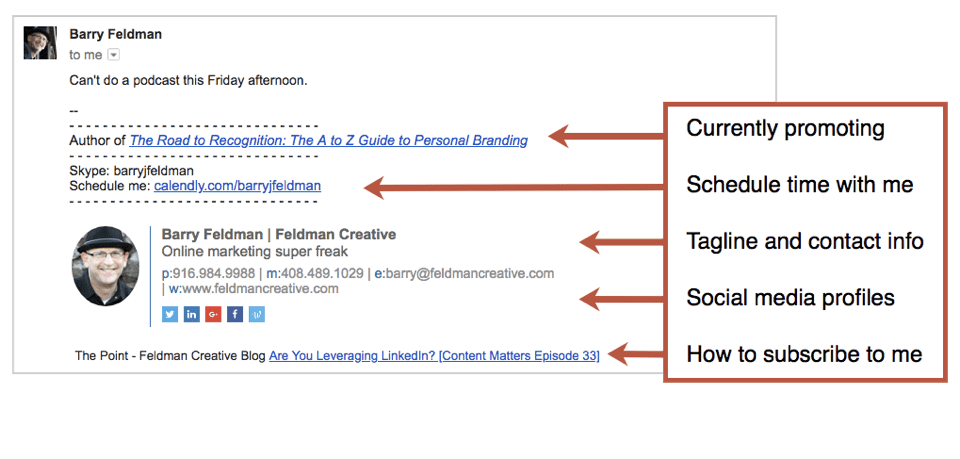
Do people actually click on links in email signatures? You bet. If you add campaign tracking code to these links, you can measure the impact. Here’s mine:
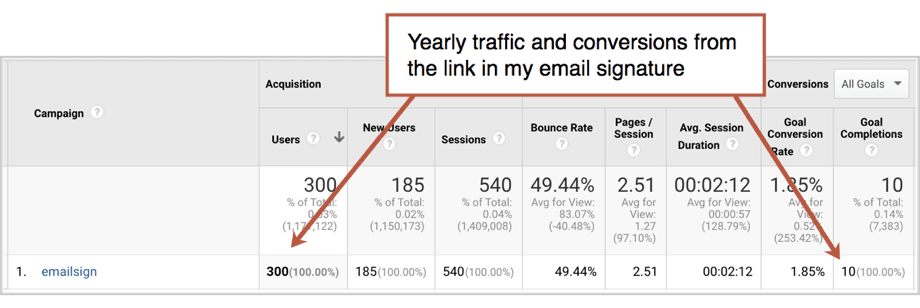
50. Add a link from your thank you page
When a visitor becomes a lead or a newsletter subscriber, they land on a thank you page. This page should not be just another dead end on your website. It’s an opportunity to share your latest, high-value article with your new lead.
51. Add the link to your chatbot flow
They landed on your site, engaged with the chatbot, but their answers to your questions disqualified them as a possible customer. What do you do with these visitors? Give them content.
We use Drift to build chatbot playbooks with qualifying questions. Qualified visitors get a scheduling widget and go right onto your sales team’s calendars. Non-qualified visitors get a link to your content.
52. Add a link to any tools and templates
If you’ve ever given away a relevant template or tool, go back and update it by adding a link to your new content. Add a little tracking code so you can measure this traffic. Otherwise, it will likely be tracked as direct or referral.
Here you can see the 1000+ visitors that visit this site every year from the links in the templates we’ve created.

53. Add a link to relevant slide decks
Here again, you’ll reap the benefits of having created original charts and diagrams. They’ll fit naturally in presentations.
Every slide that gets a graphic from an article should also get a source link in the corner. If you don’t add campaign tracking code to these links, visitors who click will appear in your Analytics as direct traffic, since they aren’t coming from a browser that provides referrer data.
54. Add a link to your Facebook header image description
The header image is highly visible and clickable. It has a description, which can include a link.
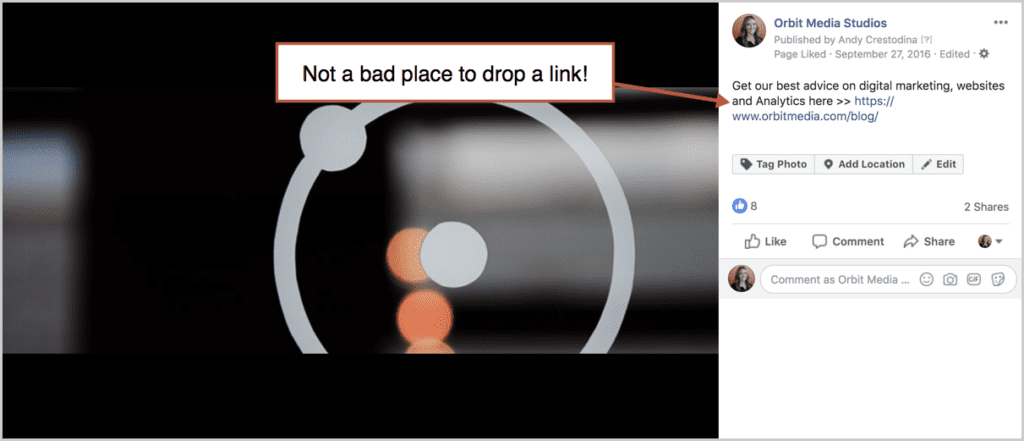
55. Add the link to your Skype or WhatsApp status
If you are active in these tools, these are highly visible places to drop a link.
56. Add a link to your 404 page
You might be surprised at how much traffic your 404 page gets. Never checked traffic to this page? This report in Analytics is the place to find out. Add a few links to your best content there.
57. Print the article, fold it up, put it in an envelope and mail it to your most valuable potential reader
It’s called “the forgotten inbox.”
It’s a counter-competitive channel.
It’s a way to reach audiences that aren’t active online.
It’s an automatic break-through-the-noise approach.
Want to be in the top 1% of content marketers? It’s easy. Just do the things that 99% of marketers do not do. This is one of them.
Section three: Post-launch promotion
Content that doesn’t gout out of date soon is evergreen. In other words, it’s not news or fast changing trends. If this is the case, continue promotion over the next 6-12 months. Here’s how:
ongoing social promotion
58. Schedule 8-10 future social posts
The opportunities will depend on the content.
- If you added anchor points deep into the article, schedule posts that bring visitors directly to those deeper sections
- If the article is relevant to a holiday, schedule posts for that day. (ie. “How to take a great selfie” is scheduled to be shared again on June 21st, National Selfie Day)
- If the article is an event recap, schedule a post to go out when registration opens for the next event.
These posts generally have fewer mentions. At this point, you’ve already mentioned everyone plenty.
59. Make the video version of the article
Put key points and supportive graphics into a slide deck and record yourself giving a mini-presentation of the article to your webcam. Keep it direct and concise.
- Use Camtasia. It makes it super simple to record and put things together (basic editing and transitions)
- Upload to YouTube (give it a good custom thumbnail and link to the original article in the description)
- Embed the YouTube video into the article near the top
Expert SEO, Alexander Rus, summarizes the three big SEO benefits (both Google and Youtube) for creating the video version of an article:
 |
alexander rus, EVERGREEN MEDIA“I always prefer to kill multiple birds with one stone. If I did the research for some amazing content piece, I will also use it for a video on the same topic. Then I embed the video into the article. This leads to a higher dwell time for the article itself and better Google rankings. Also, the external video views will push the performance of my video on YouTube. If there is a video box in the SERPs for the target keyword (depends on the user intent), there is another chance to gain even more visibility.“ |
Here’s what it looks like when the last point works out. The content ranks twice: once in video form and once as a webpage. That’s two bites at the SEO apple.
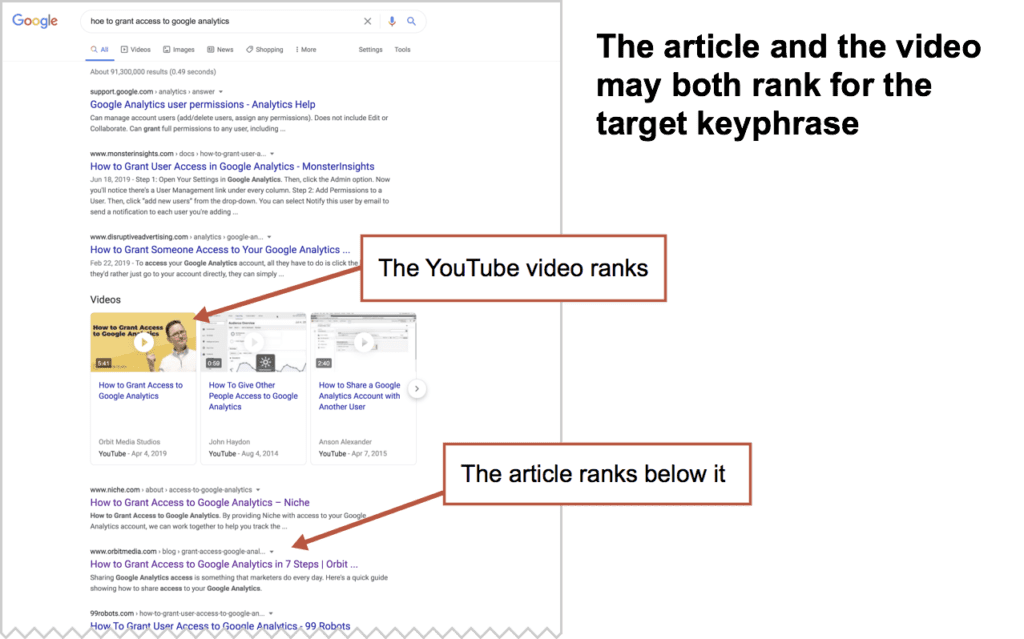
60. Make the infographic version
These long, detailed visuals are popular for a reason. They perform well. Never created one? It’s easier than you think. Venngage has an excellent guide for creating infographics. It has excellent tips of the use of numbers.
61. Create more content on related topics
The best marketers don’t create one-offs. They create interconnected hubs of content.
The best content doesn’t stand alone. It fits within a structure.
Promotion is easy through internal linking if you keep publishing. Produce content on the adjacent topics over the next three to six months.
Eventually, there will be a web of articles, on your site and others, visuals and text, created by you and by others. This is how to capture readers and draw them deeper into your articles.
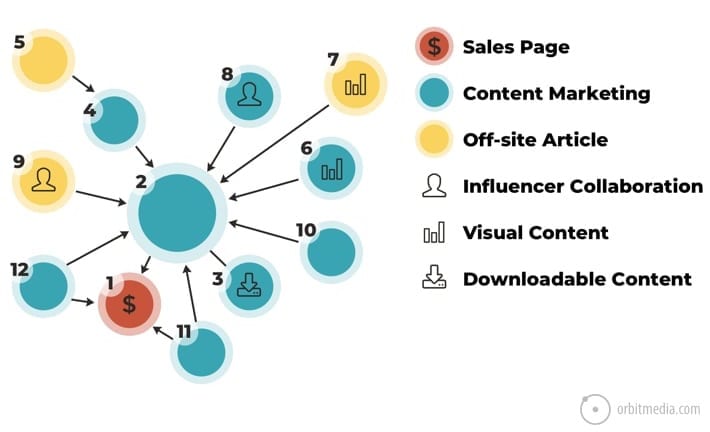
This diagram is from the 1% Content Strategy Framework, which explains not just how to promote articles but also use content to drive leads and demand through SEO.
62. Write the “Evil Twin” guest post for another website
If you wrote the “5 Best Practices for Jet Pack Maintenance” and published it on your site, it’s time to write “The 5 Biggest Jet Pack Repair Mistakes” for another site. This evil twin blog post is likely to be a great pitch, and it will naturally link back to the original on your site.
63. Mention it in your contributions to other people’s articles
Every opportunity to contribute to off-site content is an opportunity to do a bit of content promotion. Never miss the chance to mention and link to your content when you collaborate with others.
These content collaborations usually take three forms:
- The contributor quote
- The roundup
- The deep-dive interview
If your content has relevant, original data, it’s natural to link back to your content since it is the primary source.
If your content has a useful chart or diagram, incorporate it into your contribution along with an image source link. Here’s what it might look like when your contribution goes live.
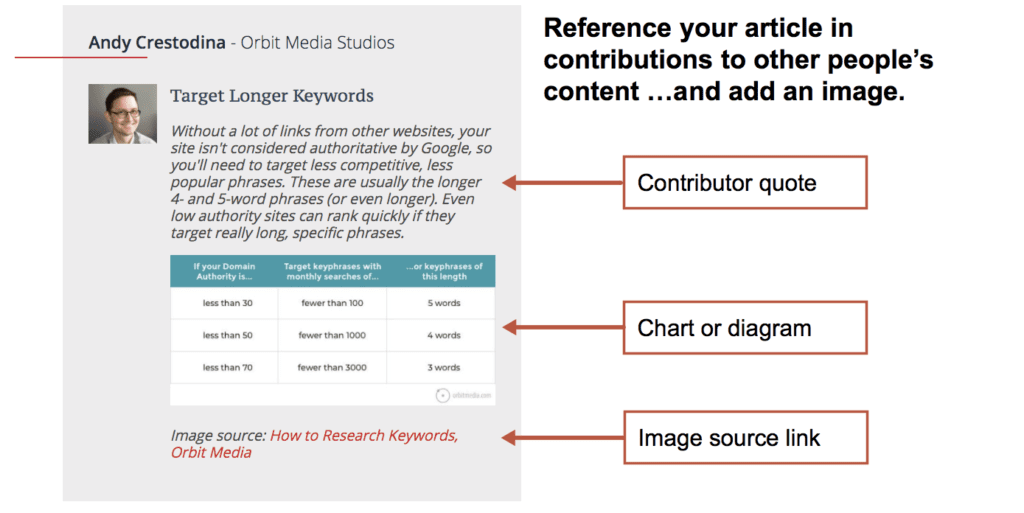
This kind of “image source link building” is one of six ways in which visuals can help your search rankings.
64. Create a guide by combining it with related articles
Once you’ve built up a little network of related articles. Package them up into a long-form guide.
Use this as gated content on each of the separate articles. This is the so-called “lead magnet” and if the calls to action are good, it’ll grow your email list.
65. Put that guide on Amazon
Voila! You’re now an author.
ProTip: LinkedIn found that calling long-form content a “guide” rather than an “ebook” had a huge impact on click through rates in social posts. It’s a guide, not an ebook.
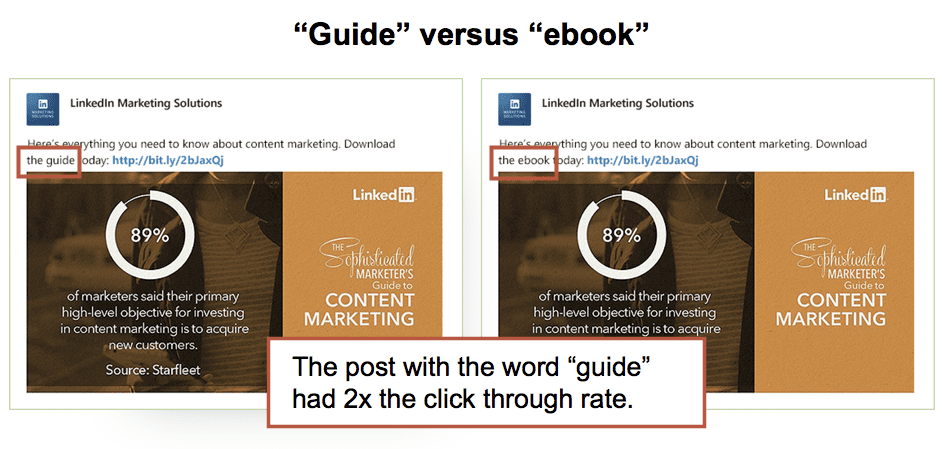
66. Mention it in presentations, webinars, podcasts
It should be very natural to mention your content in the context of a presentation. “Actually, we just wrote about this on our blog…”
If you talked about your content in a podcast interview, follow up with the host and suggest that the article be included in the show notes or in a follow-up email.
Word of mouth begins with you.
67. Mention it to prospects, clients and trainees in meetings
There are all kinds of conversations where it’s perfectly relevant to mention your recent articles. Sales meetings, customer service calls, client trainings are all places where you can offer to share the post.
Include links whenever you send follow-up emails after a meeting.
paid promotion
68. Facebook and Twitter Ads
Paid content promotion is trackable and targeted, especially on social networks. And an ad that promotes an article may get a lot more attention than an ad that promotes the business directly.
 |
Kim cooper, ALEXA.COM“Paid is a four letter word to some marketers, but I like to put a little paid oomph behind my content promotion. I’m not asking anyone to buy anything. I’m simply trying to reach my target audience. The cool thing is you don’t have to spend much if you keep your targeting very focused. One way to do this—take a site you know is popular to your audience and use it to find similar sites they also visit using Alexa’s Audience Overlap Tool. Then build a custom audience for Facebook Ads based on people who like the Facebook pages of those websites.“ |
69. Google AdWords
The cost for targeting super specific, niche phrases is often low. Set a small budget and test a few variations of ad copy. If the article has a high converting email signup form nearby, you may find that the price was worth the new subscribers.
70. Native Advertising
They’re popular because they’re effective. Networks like Outbrain cost money, but they can put your article in front of a huge audience. Test and optimize your headline and image in the social networks before you set a big native ad budget.
71. Retargeting
It’s easier than ever to invite people back to your website. Retargeting isn’t expensive or difficult to set up. Promote your content in an ad that appears only for visitors who have visited your site once before.
This one makes every other tactic more effective, because it makes your brand visible long after they checked out your post.
syndication
72. Syndicate on LinkedIn
After it’s run its course on your website, and the visits and shares seem to have died down, put the article into LinkedIn Pulse, their publishing platform. Just click the “write an article” link from the LinkedIn homepage, copy and paste.
But Andy, aren’t you worried about duplicate content? No, I am not.
It will now be visible to a new potential audience. If you’d like to bring people back to your site, post an excerpt of the article (50% – 80% of the full piece) and add a call to action at the end of the post, encouraging readers to visit your site.
Here is the traffic from those CTAs for the last year. If we added campaign tracking code to every internal link in every one of these syndicated articles, the attributable traffic would be much higher, I’m sure.

 |
barry feldman, FELDMAN CREATIVE“Syndication rules, especially if you value eyeballs over traffic. Usually, you can simply copy and paste in your posts. Better yet, find an outlet with a large audience eager to republish your posts. I syndicate most of my posts on Social Media Today, and it ranks second only to Twitter for referral traffic to my blog.“ |
73. Syndicate on Mention.com
As above, adapt it for a more general audience and paste it (full or as an excerpt) into Mention.
74. Syndicate on Converge
As above. This is another excellent place to increase the reach of a piece of content. Syndication is free through July 1st, 2020. So why not submit your best content? Start the process here.
75. Syndicate as a Google My Business post
Your GMB account has a place to post articles. This is one of the rare places to add content directly into Google’s database. Does it help local SEO? It might.
We’ve saved the best strategy for last.
repurpose content
76. Rewrite and republish
Is your article not getting traction? Maybe that’s because you only wrote it once.
As long as you don’t change the URL, rewriting an article preserves authority (inbound links) while improving the relevance (quality of the content). It is one of the most powerful SEO tactics.
The idea is that you really don’t need 1000 articles. You need 100 great articles.
Ron Swanson said it best.

This article is itself an example of the power of rewriting. We rewrite and publish this post every four years. Each rewrite was an 80% overhaul, involving 20+ hours of work.
- June 2012: First published
Kinda ranked ok, attracted a few hundred visitors per month. - August 2016: Updated and republished
Ranking higher and for more phrases, attracting 100+ visitors per week - May 2020: Update and republished again
We’ll see! I promise to update this chart to show the traffic to this latest version of this article.
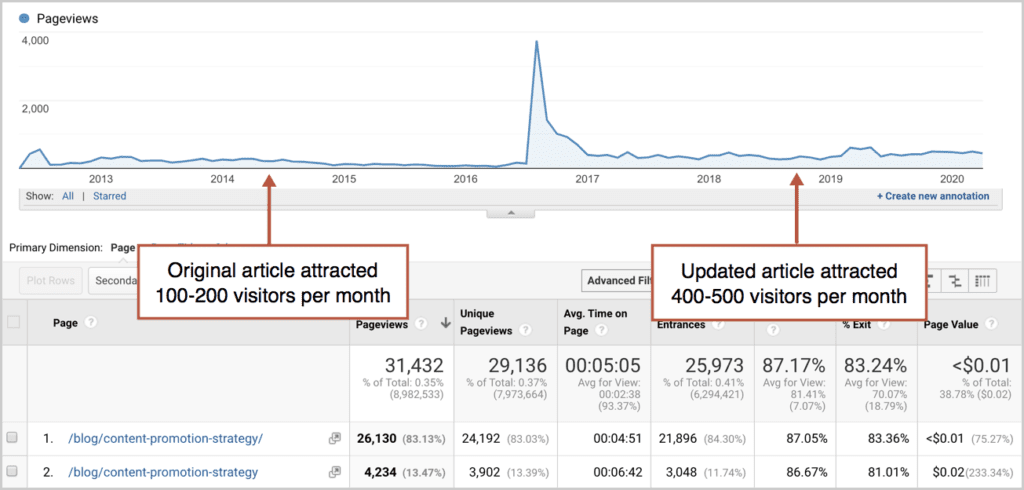
Seven other ways in which this article was built for promotion:
- 14 contributor quotes
- 10 tools mentioned
- Original diagram (that first chart)
- An image every 500 pixels (30 total visuals)
- Jump links with anchors point deep in the content
- Numbered list with a numeral in the headline
- Search optimized: Primary keyphrase: “content promotion,” secondary keyphrase: “how to promote an article”
The Content Promotion Flywheel
Every one of these content promotion tips is useless if the content stinks. But great content is equally useless if no one sees it.
Some marketers believe that creating content is just 20% of the job. Promoting that content is the other 80%.
Here’s the good news: It gets easier. Because traffic leads to more traffic.
Once you attract a visitor, the actions they take help the next round of content promotion. Different actions help in different channels.
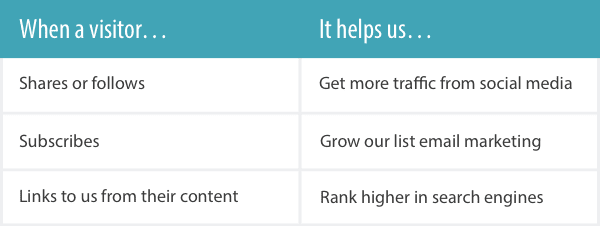
A visitor from any channel may help us with any other channel, creating a feedback loop. The idea is to create a virtuous cycle of actions taken by you, actions taken by visitors …and eventually, leads and sales.
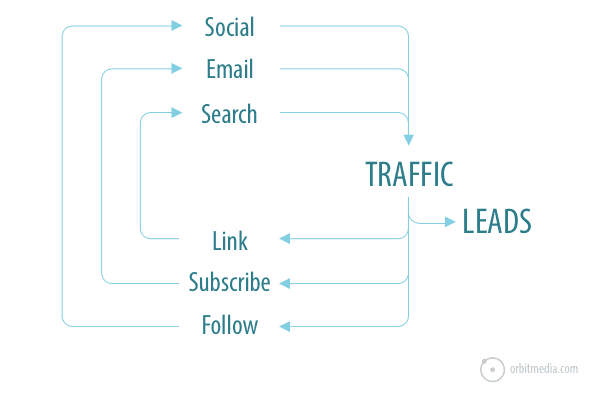
There you have it. This explains the obsession with driving traffic. It explains the importance of quality promotion, not just quality content.
Did we miss something? Help your fellow readers by leaving a tip in the comments below.
The post How to Promote an Article: 76 Content Promotion Strategies for Blog Content appeared first on Orbit Media Studios.
from Orbit Media Studios https://www.orbitmedia.com/blog/content-promotion-strategy/
via IFTTT
from
https://sarahbarnett0.wordpress.com/2020/05/27/how-to-promote-an-article-76-content-promotion-strategies-for-blog-content/
No comments:
Post a Comment